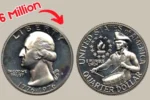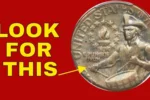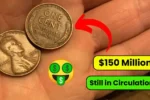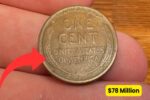The Rare Bicentennial Quarter Valued at $2.2 Billion: Myth or Reality?
The Bicentennial Quarter, released in 1975 and 1976 to honor the 200th anniversary of America’s independence, has become a favorite among coin collectors and history buffs. Recently, a claim has gone viral suggesting one of these coins could be worth a staggering $2.2 billion.
But is there any truth to this claim? In this article, we’ll take a closer look at the real facts, break down common myths, and explain what makes certain Bicentennial Quarters truly valuable.
A Quick Overview of the Bicentennial Quarter
The Bicentennial Quarter stands out due to its distinct look and historical meaning. Below are the main features that define this coin:
| Feature | Details |
|---|---|
| Minting Years | 1975–1976 |
| Obverse Design | Portrait of George Washington |
| Reverse Design | Colonial drummer, torch, and 13 stars symbolizing the original colonies |
| Dual Date | “1776–1976” instead of a single year |
| Mint Marks | None (Philadelphia), D (Denver), S (San Francisco) |
| Special Versions | Proof editions, 40% silver composition in some versions |
Why Are Bicentennial Quarters So Special?
Several reasons make Bicentennial Quarters popular among collectors and, in rare cases, highly valuable:
- Historic Importance: Issued during America’s 200th year of independence, these quarters are tied to a meaningful national event.
- Unique Design: The drummer boy on the back was selected through a public design contest and is unlike any other U.S. coin.
- Dual Date Feature: Rather than listing just one year, these coins show “1776–1976,” highlighting the bicentennial.
- Scarce Variants: Some coins contain minting errors or are made of 40% silver, making them much more valuable than regular versions.
The Truth About the $2.2 Billion Claim
The idea that a Bicentennial Quarter is worth $2.2 billion is completely unfounded. There’s no credible record of any coin reaching that value. Most likely, this rumor started as a misunderstanding or internet exaggeration. Still, some rare variants have been sold for impressive amounts—ranging from thousands to hundreds of thousands—due to specific attributes.
Factors That Influence the Coin’s Value
Several key elements help determine how much a Bicentennial Quarter is worth:
- Mint Errors: Coins with striking mistakes such as double images or off-center designs are highly sought after.
- Silver Content: Quarters with 40% silver are more desirable than standard copper-nickel coins.
- Physical Condition: Uncirculated or pristine coins command higher prices in the market.
- Scarcity: Unique traits like missing mint marks or wrong metal planchets can make a coin exceptionally rare.
Examples of High-Value Bicentennial Quarters
Here are a few examples of Bicentennial Quarters that fetched high auction prices:
- 1976-S Silver Proof Quarter
- Contains 40% silver and features a brilliant proof finish
- Auction price: Up to $19,200
- 1976-D Double Die Obverse (DDO) Error
- Shows noticeable doubling on design details
- Auction price: Up to $8,400
- 1976 Bicentennial Quarter on Wrong Planchet
- Struck on the wrong type of metal, extremely rare
- Auction price: Up to $900,000
- 1976-D Clipped Planchet Error
- Has a visible curved clip due to a minting issue
- Auction price: Up to $20,000
How to Tell If Your Bicentennial Quarter Is Rare
Think you might have a valuable quarter? Here’s what to inspect:
- Mint Mark: Look for an “S” which may indicate a silver proof or special issue.
- Coin Edge: Silver coins have a smooth, all-silver edge. Standard coins show a visible copper line.
- Minting Flaws: Search for design errors like doubling, off-center strikes, or missing features.
- Condition: Coins that are uncirculated or stored well are more appealing to collectors.
Selling Rare Bicentennial Quarters
If you believe you own a rare or valuable Bicentennial Quarter, consider these options for selling:
- Trusted coin dealers or local numismatic shops
- Online marketplaces such as eBay or Etsy
- Renowned auction houses like Heritage Auctions or Stack’s Bowers
Collector Tips for Preserving and Selling Coins
- Store coins in plastic holders or sleeves to protect them from wear and scratches.
- Never clean coins—doing so may significantly reduce their value.
- Have your coins professionally graded by services like PCGS or NGC.
- Research current coin market trends before listing or selling.
Frequently Asked Questions
Are all Bicentennial Quarters valuable?
No. Most circulated coins are worth only 25 cents. However, rare editions with errors or silver content can sell for hundreds or even thousands.
How can I tell if my quarter is made of silver?
Check for an “S” mint mark and inspect the coin’s edge—if it’s all silver without a copper stripe, it likely contains silver.
What makes error coins so collectible?
Mistakes during minting—like doubled designs or misaligned strikes—make the coin unique, which collectors love.
Can I still find Bicentennial Quarters in circulation?
Yes, though they’re less common today. Finding one of the rare high-value types in your change is unlikely but not impossible.
Where can I get a coin professionally appraised?
Organizations like PCGS or NGC offer grading and appraisal services. Local coin dealers may also provide evaluations.
Conclusion
Although no Bicentennial Quarter is worth $2.2 billion, some rare and unusual variants of this historic coin have sold for incredible prices. Whether it’s due to a minting error, silver content, or exceptional condition, these quarters continue to capture interest from collectors and history lovers alike. So, if you happen to come across one—don’t overlook it. You might just be holding a small piece of American history… and maybe even a small fortune.











